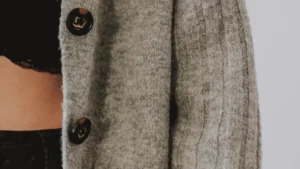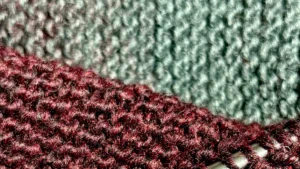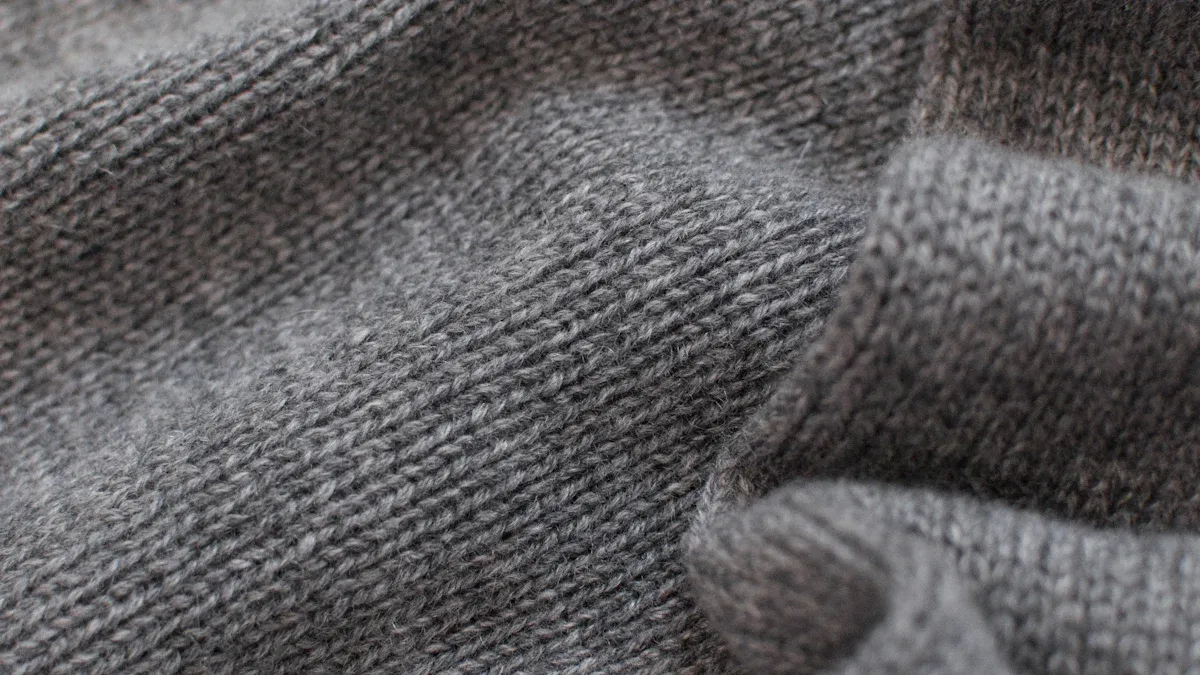
When you touch a T-shirt or soft bedding, you can feel how smooth and stretchy it is, thanks to 100 jersey knit cotton fabric. This fabric is made from pure cotton using a special knitting technique that provides comfort all day long. Many people love 100 jersey knit cotton fabric for these unique reasons:
It is soft and gentle on your skin.
It stretches and bends naturally without the need for other fibers.
It allows air to pass through and is safe for sensitive skin.
It remains comfortable, resists wrinkles, and is easy to wash.
With 100 jersey knit cotton fabric, you can feel great in every season. It keeps its shape, eliminates odors, and stays fresh after washing.
Key Takeaways
100% jersey knit cotton fabric is very soft. It stretches easily and lets air pass through. This makes it comfy to wear every day. This fabric keeps its shape well. It does not wrinkle much. It feels nice on sensitive skin because it is pure cotton and has a looped knit. Jersey knit fabric is good for T-shirts, activewear, and bedding. It moves with your body and helps you stay cool. To take care of jersey fabric, wash it inside out in cold water. Do not use high heat to dry it. Lay it flat to air dry so it stays soft and keeps its shape. Look for labels that say ‘100% cotton jersey.’ Check if the fabric is stretchy and smooth with curled edges. This helps you know it is real jersey fabric.
What Is Cotton Jersey
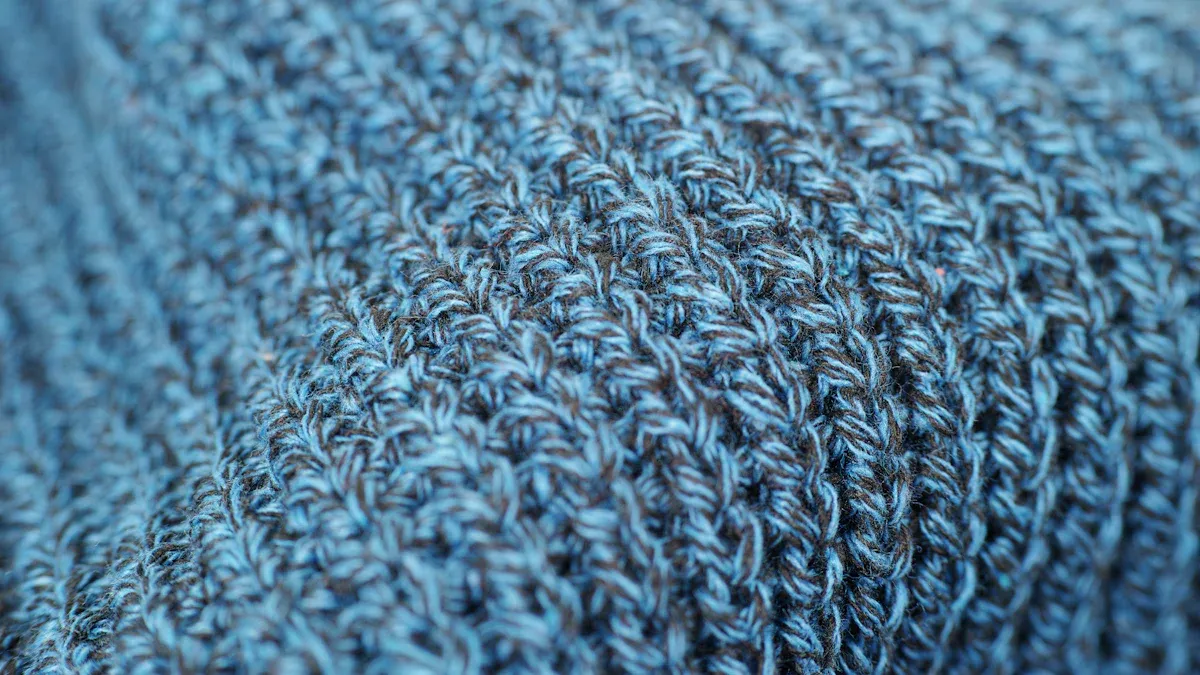
100 Jersey Knit Cotton Fabric
When you ask what cotton jersey is, you find it is very comfortable and useful. Cotton jersey fabric is made with 100% cotton in a single-jersey knit. In textile science, cotton jersey fabric is a plain, single-jersey knit. Factories use circular knitting machines to make this fabric. The needles make loops that lock together. This gives the fabric a smooth front and a ribbed back. The looped design makes jersey knit fabric thicker and warmer than woven cotton fabrics.
You will see that cotton jersey knit stretches easily, mostly across its width. It can stretch 30–50% wide and 10–20% long. When you pull and let go, it goes back to its shape, up to 40% in width. The stretch comes from the way it is knit, not from extra fibers. Cotton jersey fabric feels soft and smooth on your skin. It does not wrinkle much and keeps you comfy all day.
Jersey knit fabric is used for T-shirts, underwear, socks, and bedding. You can find good jersey cotton fabric in many things you use every day. The fabric is soft and lets air through, so it is good for people with sensitive skin. When you pick 100 jersey knit cotton fabric, you get pure cotton with no blends or fake fibers. This makes it different from other knits that use polyester or spandex.
Tip: If you want a fabric that is soft, stretches, and stays cool, choose 100% cotton jersey.
Jersey Knit Fabric vs Other Fabrics
You might wonder how jersey knit fabric is different from other fabrics. The main difference is how the yarns are put together and how the fabric feels. Jersey knit fabric uses loops that lock together. Woven cotton fabrics use two sets of yarns that cross each other. This changes how the fabric stretches, breathes, and feels on your skin.
Here is a table to help you see the differences:
Feature | Jersey Knit Fabric (Knitted) | Woven Cotton Fabric (Woven) |
|---|---|---|
Yarn Arrangement | Yarns are looped together forming interlocking loops | Two sets of yarns (warp and weft) interlaced at right angles |
Stretch | High elasticity; stretches naturally in multiple directions | Minimal stretch; stable and rigid structure |
Fabric Properties | Soft, breathable, flexible, lightweight, smooth, conforms to body shape | Durable, shape-retentive, structured, less flexible |
Smallest Unit | Loop (loop stem and extension line) | Weave point (intersection of warp and weft yarns) |
Resulting Effects | Extensibility, air permeability, softness | Stiffness, durability, minimal stretch |
Jersey knit fabric is special because it stretches in all directions. The loops move and bend, so the fabric feels soft and flexible. Woven cotton fabrics feel stiff and do not stretch much. This makes jersey fabric great for clothes that need to move with you, like T-shirts and sportswear.
You can also compare jersey knit fabric to other knit fabrics, like rib knit or interlock knit. Each type feels and works a little differently:
Knit Fabric Type | Feel and Texture | Stretch and Stability | Typical Uses | Key Performance Traits |
|---|---|---|---|---|
Jersey Knit | Flat, smooth face with slightly ribbed back; soft and stretchy; prone to edge curling | Moderate stretch; less stable; curls at edges | T-shirts, casual dresses, lightweight tops | Comfortable, versatile, but edges curl and less shape retention |
Rib Knit | Vertical ribs; textured surface; snug fit | Highly elastic; excellent shape retention and durability | Cuffs, necklines, waistbands, form-fitting garments | Exceptional elasticity, maintains fit, durable |
Interlock Knit | Smooth on both sides; thicker and more stable than jersey | Less stretch than jersey; very stable; minimal curling | High-quality t-shirts, dresses, sportswear | Stable, polished look, luxurious feel, enhanced comfort |
When you pick cotton jersey knit, you get a fabric that is smooth, soft, and stretches a bit. It is good for everyday clothes. Rib knit stretches more and keeps its shape, so it is good for cuffs and collars. Interlock knit is thicker and more stable, with a nice look.
Jersey fabric made from 100% cotton is different from blends. You get natural softness, breathability, and comfort with no fake fibers. Good jersey cotton fabric does not pill and keeps its shape after washing. When you choose 100 jersey knit cotton fabric, you get a fabric that is gentle, flexible, and easy to care for.
If you want to know what cotton jersey is, remember these things:
Cotton jersey fabric uses a single-knit with loops that lock.
Jersey knit fabric stretches and feels soft.
100 jersey knit cotton fabric has only cotton, not blends.
Jersey fabric is good for T-shirts, bedding, and more.
Cotton jersey knit gives you comfort, stretch, and breathability. You can trust it for clothes that feel good and last.
Key Features of Cotton Jersey Fabric
Softness and Comfort
When you touch cotton jersey fabric, you notice its soft and gentle feel right away. The looped structure of jersey knit fabric creates a smooth surface that feels pleasant against your skin. This softness makes jersey fabric a favorite for T-shirts, pajamas, and bedding. You experience comfort all day because cotton fibers are naturally soft and breathable. Many people with sensitive skin choose cotton jersey fabric for its gentle touch. The comfort you get from this fabric comes from both the cotton and the unique knit.
Stretch and Flexibility
Jersey knit fabric stands out for its stretchability. The loops in the knit allow the fabric to stretch across its width and length. You can pull a piece of jersey knit, and it will move with you. However, 100 percent cotton jersey knit fabric does not contain lycra or elastane, so it stretches less and does not snap back as well as blends. This means the fabric feels flexible but may not hold its shape as tightly as cotton lycra blends. For loose-fitting clothes, this level of stretch works well and adds to your comfort.
Breathability and Moisture-Wicking
One of the best properties of jersey knit fabric is its breathability. The looped design lets air flow through, keeping you cool. Cotton jersey fabric absorbs moisture well—up to 25% of its weight—so it soaks up sweat and helps you stay dry. However, it dries more slowly than polyester jersey fabrics, which wick moisture away and dry fast. You will find that cotton jersey fabric is highly breathable, making it a good choice for warm weather and everyday wear. The fabric breathability comes from both the cotton fibers and the knit structure.
Note: Cotton jersey fabric keeps you comfortable, but for intense sports, polyester jersey fabric may keep you drier.
Texture and Drape
Jersey knit fabric has a smooth texture and drapes well over your body. Textile engineers use tests like the ISO 9073-9 drape meter to measure how the fabric hangs. Cotton jersey fabric usually has a low drape coefficient, which means it is flexible and flows nicely. The fabric moves with you and does not feel stiff. This drape, along with the soft and breathable nature of cotton, adds to the comfort and style of your clothes. The characteristics of jersey knit fabric make it perfect for garments that need to look and feel relaxed.
Uses of Jersey Fabric
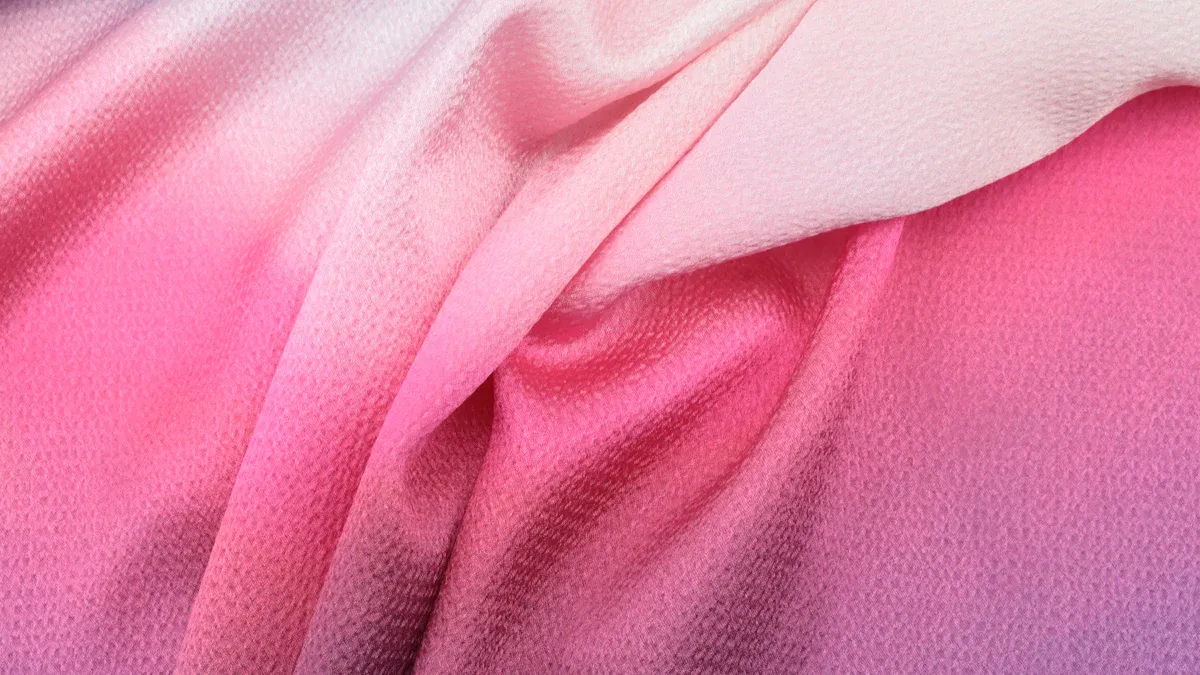
Everyday Clothing
You see cotton jersey fabric in many types of clothing you wear every day. T-shirts, casual dresses, and blouses often use jersey fabric because it feels soft and stretches with your movements. Many people choose this fabric for sleepwear and baby clothes. The softness of cotton jersey sheets and garments makes them gentle on your skin. You enjoy comfortable and stylish clothing that keeps you cool in warm weather. The best cotton jersey clothing gives you a relaxed fit and easy care. You can find jersey fabric in both lightweight and thicker styles, so it works for many applications of cotton jersey fabric.
The popularity of jersey knit fabric comes from its ability to create comfortable and stylish clothing for all ages.
Activewear and Sportswear
Jersey fabric is a top choice for activewear and sportswear. You need clothing that moves with you and keeps you comfortable during exercise. Cotton jersey fabric stretches and breathes, making it perfect for gym shirts, yoga pants, and athletic shorts. The fabric absorbs sweat and allows air to flow, so you stay cool and dry. Many athletes and fitness fans pick jersey fabric for its flexibility and softness. You also find it in team uniforms and sports jerseys. The applications of cotton jersey fabric in sportswear help you perform your best while feeling good.
Home Textiles
You can bring the comfort of jersey fabric into your home. Many people use jersey sheets and pillowcases for their beds. The softness of cotton jersey sheets helps you sleep better by feeling gentle on your skin. Jersey knit fabric application in bedding includes blankets that are warm yet lightweight. You also see jersey fabric in home decor, such as curtains and throws. The fabric resists wrinkles, so your bedding and home textiles look neat. You can choose from many colors and patterns because jersey fabric dyes and prints easily. The applications of cotton jersey fabric in home textiles give you comfort and style every day.
Jersey sheets and pillowcases feel soft and breathable.
Blankets made from jersey fabric are cozy and light.
The fabric resists wrinkles and keeps a tidy look.
You can find many colors and prints for your home.
Tip: If you want bedding that feels like your favorite T-shirt, try jersey sheets for a cozy night’s sleep.
How to Identify Jersey Knit Fabric
Visual and Tactile Clues
You can spot jersey fabric by looking at its surface and feeling its texture. When you look closely, you will see tiny columns of Vs on the front. This smooth side is called the technical face. If you turn the fabric over, you will notice rows of small semicircles. These patterns help you tell jersey fabric apart from other types.
Jersey fabric stretches more from side to side than up and down. You can test this by gently pulling the fabric across its width. It will feel soft and flexible in your hands. When you crush or squeeze it, jersey fabric bounces back and does not feel stiff. The edges of jersey fabric often curl up, which is another clue. Textile experts say that jersey fabric looks calm and smooth. The texture feels even and pleasant, which makes it part of the “Elegance” group of fabrics.
Tip: If you want to check if a fabric is jersey fabric, stretch it gently and look for edge curling and a soft, smooth feel.
Checking Labels
You can also identify jersey fabric by reading the label on clothing or fabric rolls. Most labels list the fabric type and fiber content. Look for words like “100% cotton jersey” or “jersey knit.” These terms tell you that the fabric is pure cotton and made with the jersey knitting method.
Some labels may use phrases such as “single jersey” or “cotton jersey fabric.” If you see blends like “cotton-polyester jersey,” you know the fabric is not pure cotton. Always check for “100% cotton” if you want the natural benefits of jersey fabric. Labels can also mention care instructions, which often suggest gentle washing and drying. This matches the easy-care nature of jersey fabric.
A quick table can help you remember what to look for:
Label Term | What It Means |
|---|---|
100% Cotton Jersey | Pure cotton jersey fabric |
Jersey Knit | Made with jersey knitting |
Cotton-Polyester Jersey | Cotton blended with polyester |
Single Jersey | Lightweight jersey fabric |
When you use both your senses and the label, you can easily find real jersey fabric for your needs.
Caring for Cotton Jersey Fabric
Washing and Drying
You want your jersey fabric to stay soft and last a long time. Start by turning your garments inside out before washing. This protects the outer surface from friction and helps prevent pilling. Use a mesh laundry bag to keep your jersey fabric from tangling or stretching in the wash. For best results, wash your clothes in cold or lukewarm water. Choose a gentle detergent and select the delicate cycle if you use a machine. Hand washing with lukewarm water gives even more protection.
After washing, avoid wringing out your jersey fabric. Gently press out extra water between towels. Lay your clothes flat on a towel or mesh rack to air dry. Keep them away from direct sunlight to prevent fading. Do not use high heat or tumble dryers, as these can shrink the fabric and damage the fibers. Air drying helps your jersey fabric keep its shape and softness.
Tip: Air your jersey fabric between wears to reduce washing and keep the fabric fresh.
Preserving Quality
You can keep the quality of your jersey fabric high by following a few simple steps. Always fold your garments along natural seams and store them flat. Hanging heavy jersey fabric can cause it to stretch out of shape. Use breathable cotton bags or boxes for storage. Avoid plastic bags, which can trap moisture and lead to mildew.
Here is a quick table to help you prevent common problems:
Problem | Cause | How to Prevent |
|---|---|---|
Pilling | Friction during washing | Wash inside out, use mesh bags |
Shrinking | High heat in washing or drying | Use cold water, air dry |
Misshaping | Hanging heavy garments | Fold and store flat |
Fading | Sunlight or harsh detergents | Dry away from sun, use gentle soap |
Store your jersey fabric in a cool, dry place. Add lavender or cedar sachets to keep pests away. Make sure your fabric is completely dry before putting it away. These steps help your jersey fabric keep its softness, shape, and quality for many years. Jersey fabric stands out for its durability. The strong knit structure resists stretching and pilling, so your clothes look good after many washes. Compared to other cotton fabrics, jersey fabric keeps its original look and feel longer, making it a smart choice for everyday wear.
You can trust jersey fabric for comfort, flexibility, and easy care. Many people choose jersey fabric for clothing because it feels soft and stretches with your movements. This fabric keeps its shape and looks good after washing, so your garments last longer. Quality tests show that jersey fabric meets important standards for strength and appearance, which means you get reliable clothing for daily life. You will find jersey fabric in many garments, from T-shirts to bedding. If you want clothing that feels great and works for many uses, jersey fabric is a smart choice.
FAQ
What makes 100% cotton jersey fabric different from cotton blends?
You get pure softness and breathability with 100% cotton jersey. Blends often add polyester or spandex, which can change the feel and stretch. Pure cotton jersey feels natural and gentle on your skin.
Can you use cotton jersey fabric for winter clothing?
You can wear cotton jersey in winter. Layer it under sweaters or jackets for extra warmth. Thicker jersey fabrics also work well for long-sleeve shirts and pajamas.
Does cotton jersey fabric shrink after washing?
Cotton jersey may shrink a little after the first wash. Wash in cold water and air dry to keep the size. Always check the care label for best results.
How do you stop jersey fabric edges from curling?
Try hemming or adding a simple stitch along the edge. This helps keep the fabric flat. You can also use fabric tape for a quick fix.
Is cotton jersey fabric good for sensitive skin?
Yes, cotton jersey works well for sensitive skin. The fabric feels soft and does not trap heat. You avoid irritation because it uses only natural cotton fibers.




